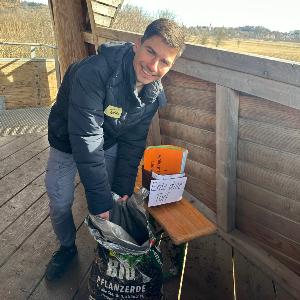Hands-on climate education
12 Mar 2024
As part of the project “Moors in a Changing Climate”, students from the geography teacher training course explained to elementary school classes how moors can help mitigate climate change.
12 Mar 2024
As part of the project “Moors in a Changing Climate”, students from the geography teacher training course explained to elementary school classes how moors can help mitigate climate change.

Project manager and LMU geographer Alexandra Stumbaum | © LMU
To achieve climate neutrality by 2045, solutions are needed that will permanently remove CO₂ from the atmosphere. One such solution is to rewet moors. Why? Because in Germany alone, heavily drained bog soil is the cause of around 53 million tons of greenhouse gases every year.
To raise awareness of this issue among children, LMU geographer Alexandra Stumbaum launched the project “Moors in a Changing Climate”. The basic idea is simple: Future geography teachers get to broaden their experience and teach elementary school classes on site in the Ampermoos moor near Grafrath, to the west of Munich.
“This is a practical seminar that gives the trainee teachers close contact with school classes,” says Stumbaum, who has been seconded as a teacher to the Department of Geography since 2021. The project has gone down well among her students:
The discipline of geography is the key that unlocks access to nature, natural phenomena, the climate and climate change. If you can give children an understanding of the issues from an early age, that is something very special for the future.Stefanie Obermeier, project member and trainee teacher
During the project in February 2024, some 75 third-grade schoolchildren experienced the fascination of moors for themselves. At a series of interactive stations, they also gained an insight into moors’ role in mitigating climate change.
On arriving at the moor, the children are welcomed by “Lisa the Butterfly” and “Tom the Toad” in a pavilion at the foot of the Ampermoos nature reserve. Using these cardboard cutout figures, the students make a game of explaining to the children how the moor is too dry for the animals and asking what the reasons might be. The children thus get involved right from the word go and contribute their own ideas.
The budding geography teachers accommodate the children’s suggestions, telling them about how moors come into existence and what function they perform. They show the children that, for a variety of reasons, the Ampermoos moor is losing its role as a carbon sink: Today, it has become a “tired climate hero”.
Their rubber boots sink deeper and deeper in the mud as the morning wears on, but the elementary school children remain fascinated by the words of students Carmen Mikluschka and Stefanie Obermeier. The children themselves conduct simple experiments to learn what a pH value is and discover that the moor soil should ideally be acidic due to its store of carbon.
It is already very late to start actively doing things to mitigate climate change. So, I think it is especially important to start doing so as early as possible – preferably while still at school.Tobias Enders, member of the project

Aspiring geography teacher Tobias Enders prepares his hands-on station for peat-free gardening. | © LMU
“It is already very late to start actively doing things to mitigate climate change,” Tobias Enders, another member of the project, concedes. “So, I think it is especially important to start doing so as early as possible – preferably while still at school.”
The group of teacher training students takes a moment to prepare shovels and plant pots: The next class of third-graders is already waiting excitedly to see what they can discover at the last activity station on this day of the Ampermoos project.
For Alexandra Stumbaum and the students, it is extremely important to show even the youngest generation what options are open to them, how they can already take action to mitigate climate change. “It is one thing to tell the children that they and their parents should pay attention to their carbon footprint next time they book a flight,” the project manager explains. “But it is questionable whether or not that ever actually gets done.”
Gardening presents a more child-friendly option. “In the spring, everyone brings out their plant pots and makes their way to the garden center,” the geographer continues. “So, what do they need to look out for? By using peat-free soil and helping to protect the moors, they can actively contribute to mitigating climate change.”
In the spring, everyone brings out their plant pots and makes their way to the garden center. So, what do they need to look out for? By using peat-free soil and helping to protect the moors, they can actively contribute to mitigating climate change.Alexandra Stumbaum, Project manager
The “Moors in a Changing Climate” project is very close to the geography lecturer’s heart. Having grown up near the Ampermoos, she happily tells of her deep affinity for nature in general and the moor in particular. “Standing here in this special place just puts a smile on your face,” she says. “We have a unique Alpine panorama in the background, and the moor invites you to cast your gaze further afield. Under certain circumstances, it can also help mitigate climate change. It was very important to me to get this message across; and now we can even combine it with teacher training.”
And the students? There is one thing above all that they want the children to understand: that they should never stop being inquisitive and committed to countering climate change. “The way they have got involved has been fantastic," Stefanie Obermeier says. "I hope that never ends."